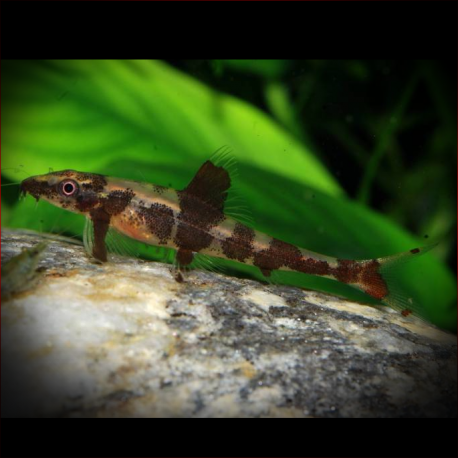More info
Datasheet
| Minimum Tank Size | 60 litres / 15.85 US gallons |
| Maximum Size | 5.0cm / 1.97inches |
| Temperature | 20°C / 68.00°F - 25.5°C / 77.90°F |
| Hardness | 1.01dgH / 18ppm - 12.05dgH / 215ppm |
| pH | 6.0-7.5 |
General Description
Homaloptera ogilviei is a rare species in the aquarium trade, occasionally imported among shipments of other species and known by the monikers "lizard" or "gecko" loach. Distinguished by its pale pinkish-brown coloration with irregular dark markings and unique fin orientations, it thrives in clean, well-oxygenated waters with gravel or sand substrates, rocks, driftwood, and adaptable aquatic plants. These loaches possess specialized morphological features for life in fast-flowing waters, enabling them to cling tightly to surfaces using a powerful sucking cup mechanism.
Aquarium Setup
The ideal tank setup for H. ogilviei includes clean, well-oxygenated water with a turnover of 10-15 times per hour, facilitated by an oversized filter and additional powerheads if needed. Utilize gravel or sand substrate mixed with water-worn rocks and pebbles, along with driftwood and aquatic plants like Microsorum and Anubias spp. They prefer stable water conditions and feed on biofilm, requiring a mature setup with aufwuchs growth on surfaces except the viewing pane. A secure cover is essential due to their climbing behavior.
Behaviour
H. ogilviei is not aggressive but has specific requirements that limit suitable tankmates. It thrives in aggregations, displaying bolder behaviors in groups of six or more. These loaches exhibit intriguing interactions, often positioning themselves closely facing the water flow. They prefer submerged vegetation or woody structures, perching on fins when at rest. Balitorid species, like H. ogilviei, are adapted for fast-flowing waters, moving by crawling or hopping over surfaces due to their flattened bodies and specialized fins.
Feeding and Diet
Specialized grazers, H. ogilviei feeds on biofilm, small crustaceans, insect larvae, and other invertebrates in the wild. In captivity, they may accept sinking dried foods, but regular meals of live or frozen Daphnia, Artemia, and bloodworms are essential for optimal health. It is recommended to provide a tank with algae growth and aufwuchs. When purchasing emaciated specimens, a consistent source of suitable foods in a low-competition environment is crucial for their recovery.
Reproduction & Dimorphism
There is no recorded information on the reproductive behavior of H. ogilviei in captivity. Sexually mature females are generally slightly larger and fuller-bodied than males. These loaches are presumed to be seasonal spawners in their natural habitat, exhibiting unique characteristics such as fin orientations and ventral positioning.
Habitat and Distribution
Natively found in flowing streams with clear, oxygen-saturated water, H. ogilviei is distributed across the Malay Peninsula in Malaysia and southern Thailand. They inhabit areas close to riffles and runs, preferring slower-moving stretches with aquatic plants, submerged roots, driftwood, or leaf litter. They coexist with various aquatic species in their natural habitat, adapting well to fast-flowing water conditions typical of their ecosystem.

